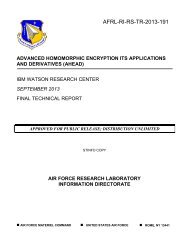EN100-web
EN100-web
EN100-web
You also want an ePaper? Increase the reach of your titles
YUMPU automatically turns print PDFs into web optimized ePapers that Google loves.
Research and Innovation<br />
Simulations Show<br />
how Lightning Creates<br />
Antimatter<br />
by Christoph Köhn and Ute Ebert<br />
Active thunderstorms can emit gamma-rays and even<br />
antimatter. In fact, growing lightning channels can act<br />
as enormous particle accelerators above our heads.<br />
Researchers of the Multiscale Dynamics group at CWI<br />
have modelled and simulated these multiscale<br />
processes. They corrected previous calculations of<br />
gamma-ray emissions and, for the first time, computed<br />
the emission and propagation of positrons and<br />
neutrons. The neutrons are produced in nuclear<br />
reactions in air and might reach the ground.<br />
Since 1994 we have known that active thunderstorms can<br />
generate ‘terrestrial gamma-ray flashes’, and in 2009<br />
NASA’s Fermi satellite detected that thunderstorms can even<br />
launch beams of antimatter, namely positrons, the anti-particles<br />
of electrons (see link below). The positrons were so<br />
numerous that they could be<br />
detected at 500 km altitude by the<br />
satellite. Other researchers claim<br />
that growing lightning channels<br />
would also emit neutrons, though<br />
these observations are still under<br />
debate. Gamma rays, positrons and<br />
neutrons are typically generated in<br />
nuclear reactions – so what is<br />
going on in the clouds above our<br />
heads and around our airplanes?<br />
Should we worry? And what radiation<br />
is liberated when a lightning<br />
channel approaches ground?<br />
gamma-radiation when colliding with molecules; and the<br />
gamma-radiation can subsequently create electron positron<br />
pairs and liberate neutrons and protons from the nuclei of air<br />
molecules. But the voltage in thunderstorms can reach the<br />
order of 100 MV, while the highest voltages anticipated for<br />
future long distance electricity nets are 1.2 MV. Therefore,<br />
technology oriented models have to be extended to deal with<br />
the extreme conditions of thunderstorms.<br />
The emission of particles with<br />
such high energies was not<br />
expected by lightning experts.<br />
Researchers from the Multiscale<br />
Dynamics research group at CWI,<br />
headed by Ute Ebert, were well<br />
positioned to simulate and understand<br />
this phenomenon as they<br />
were already investigating electron<br />
acceleration in technological<br />
discharges at atmospheric pressure,<br />
in the context of energy efficient<br />
plasma processing and plasma medicine and in the context<br />
of high voltage switches for electricity nets.<br />
In essence, growing discharges in nature and technology can<br />
accelerate electrons to very high energies within an ionization<br />
wave. This process occurs very far from equilibrium in a<br />
small region around the tip of the growing channel, and the<br />
available electric energy is converted there into electron<br />
acceleration, and ionization and break-up of a small fraction<br />
of molecules, while the gas overall remains cold. If the electron<br />
energy is high enough, the electrons can generate<br />
NASA’s illustration how gamma-rays (pink), and electrons and positrons (yellow) are launched into<br />
space from a thunderstorm. The electrons and positrons follow the geomagnetic field lines.<br />
Credit: NASA/Goddard Space Flight Center/J.Dwyer, Florida Inst. of Technology<br />
To accurately model these processes, models have to cover<br />
multiple scales in space and in energy. The CWI models start<br />
out from parameterizations of the processes that occur when<br />
electrons or other particles collide with air molecules. Some<br />
of these parameterizations had to be revised. They enter into<br />
the discharge model on the smallest scale which is of<br />
MC/PIC type, i.e., a Monte Carlo model with Particle in Cell<br />
approximation for the coupling of electric charges to the<br />
electrostatic Poisson equation [1]. In this model, the electrons<br />
follow their classical or relativistic path between air<br />
molecules, and their collisions with a random background of<br />
molecules are modelled with a Monte Carlo process. Proper<br />
averaging over the random electron motion (by taking<br />
moments of the Boltzmann equation and by truncating after<br />
the fourth moment) has delivered a set of four coupled partial<br />
differential equations for electron density, electron flux, electron<br />
energy, and electron energy flux [2]. An important and<br />
difficult aspect of both the MC/PIC model and the PDE<br />
model is the coupling of the electric charge density to the<br />
electrostatic Poisson equation. Solving the Poisson equation<br />
is a classical numerical problem. In combination with local<br />
grid refinement it is also a challenging problem, since in each<br />
time step Poisson equations are to be solved on computational<br />
grids that move in time.<br />
A particular challenge in the present project was to also<br />
bridge the many orders of magnitude of particle energies: the<br />
40<br />
ERCIM NEWS 100 January 2015



